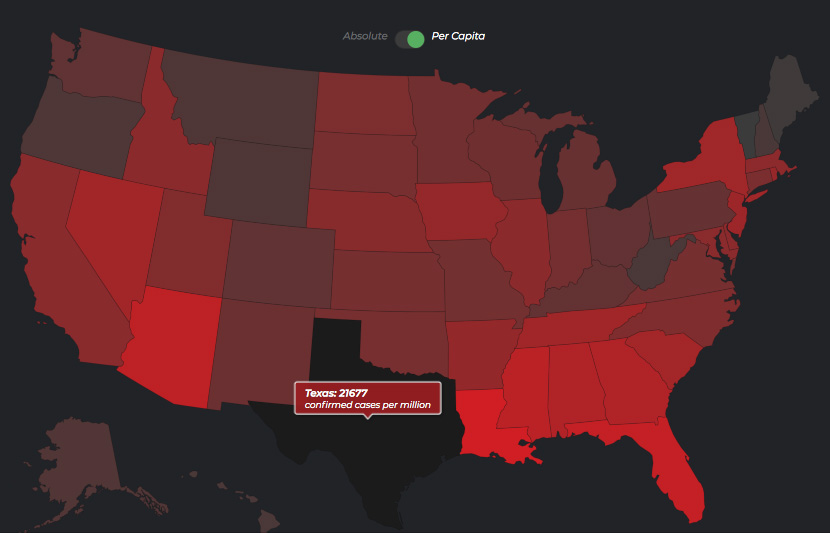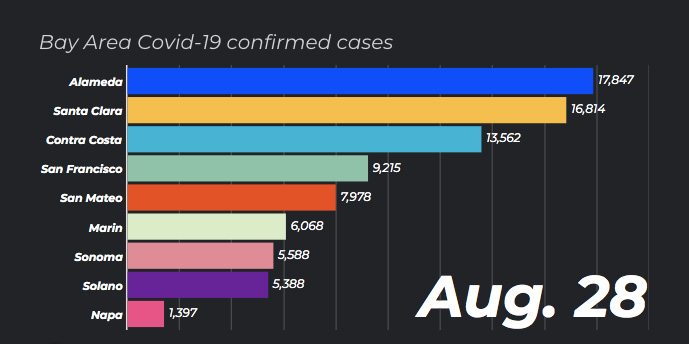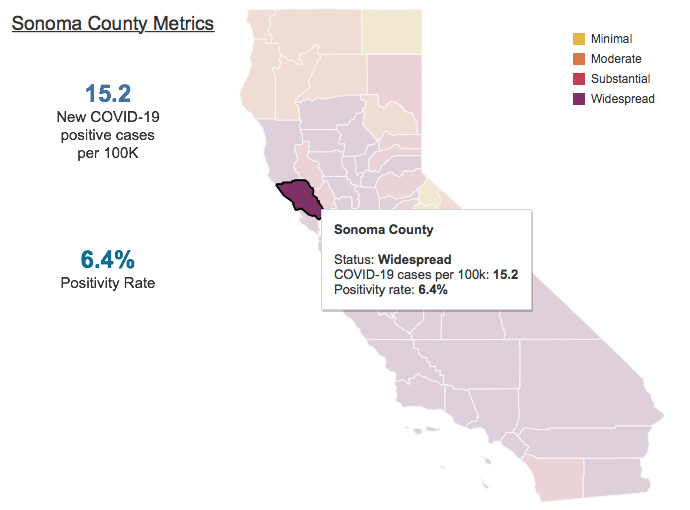In this Covid-19 update, we get into the wild week at the U.S. Food and Drug Administration since the agency plays such an crucial role in treatment options, try to make sense of the state’s new metrics system and check in with all nine Bay Area counties.
In a bit of positive news, Bay Area residents may soon get the chance to have their hair cut indoors for the first time in several months.
Let’s dig in.
U.S.
- Confirmed Cases: 5,913,941
- Deaths: 181,800
Source: John Hopkins University Coronavirus Resource Center COVID-19 global tracking tool as of Saturday at 9:28 a.m.
The U.S Food and Drug Administration made national news twice Friday. The first headline was the sudden dismissal announcement of spokesperson Emily Miller. Miller was known prior to her political appointment to the FDA as a reporter for various news outlets, including a recent stint at One America News, work she did as a communications director for Sen. Ted Cruz and a book she penned titled “Emily Gets Her Gun: But Obama Wants to Take Yours.”
Her social media accounts illustrate very partisan beliefs and she has posted alarming content for someone in a communications department for a federal safety agency, especially during a pandemic. The firing offense appears to be the Sunday press release rollout about emergency use authorization for convalescent plasma as treatment for Covid-19. The statement was uncommonly politicized and repeatedly celebrated Trump, which is acceptable for campaign material but widely considered inappropriate for FDA communication.
“It is proven to reduce fatality by 35%” -Pres. Trump on #convalescentplasma for over 70,0000 #COVIDー19 patients in clinical trials for months.
— emily miller (@emilymiller) August 23, 2020
Stephen Hahn, FDA commissioner, who apparently relieved Miller of her duties, had himself claimed on Twitter that the plasma treated was “shown to be beneficial for 35% of patients.” The statistic was immediately called out as grossly exaggerated by a breadth of health professionals because the study cited was based on a limited sample group and reflected an effective rate below what Hahn claimed — in some cases, much lower.
Hahn apologized Monday for the misstatement. He then removed Miller Friday — she had been on the job for 11 days.
The second FDA headline Friday came with the news that yet another emergency use authorization was granted for the drug remdesivir as treatment on all hospitalized Covid-19 patients. Though a government study published in May in the New England Journal of Medicine found the drug showed promise in shortening median recovery time by four days, it did not provide sufficient evidence that it was effective in saving lives. Researchers reported that about a fifth of the patients who received remdesivir experienced “serious adverse events.”
Based on that study, the FDA had approved in May the drug’s use for Covid-19 patients who require oxygen but not for those on ventilators. No further studies have been published to suggest its use is effective or safe beyond that. Again, scientists and medical professionals are questioning the agency’s decision to expand the drug’s use without further research.
As of Friday, Congress has not made any positive movement toward a stimulus bill. The extended Pandemic Unemployment Assistance benefit expired at the end of July — the Labor Department reported Thursday that another 1 million people filed for first-time unemployment benefits last week.

California
- Confirmed Cases: 698,724
- Deaths: 12,846
Source: John Hopkins University Coronavirus Resource Center COVID-19 global tracking tool as of Saturday at 9:28 a.m.
Gov. Gavin Newsom announced Friday that California is scrapping the County Monitoring List method for a new four-tier, color-coded system that gives more control to the state over which businesses can open in specific counties. It also aims to reduce chaotic back-and-forth opening statuses for impacted industries and simplifies goals into two metrics: number of positive cases per 100,000 residents and test positivity rate.
The California Department of Public Health County Monitoring List webpage is no longer available as of Friday afternoon.
In its place is now the “Blueprint for a Safer Economy” webpage that breaks down tier levels and offers county-specific progress data. The tiers, from highest to lowest risk, are widespread, substantial, moderate and minimal. Counties must remain in any tier for at least 21 days before they are permitted to move forward and must be able to meet the next tier’s criteria for two consecutive weeks. Tiers will be downgraded by the state if a county’s metrics worsen for two consecutive weeks.

The change allows for some additional indoor businesses to reopen at limited capacity, even in the worst hit areas. As of Aug. 31, counties deemed widespread can reopen indoor hair salons, barbershops, retail and shopping malls at 25 percent capacity with modifications, including some common area closures. Capacity and common area allowance increase as counties improve metrics and move through tiers.
Indoor dining at 25 percent capacity or 100 people, whichever is fewer, will be allowed in the substantial tier. Outdoor bars can reopen once a county is deemed moderate and indoor bars at half capacity are allowed in the minimal tier. The CDPH has published an online spreadsheet with further details about how specific industries will be impacted by the new system.
Schools in the widespread tier cannot reopen schools for in-person instruction unless they’ve been granted a waiver. Schools in counties that have been in the substantial tier for at least two weeks can reopen in accordance to state guidelines.
What is not made clear on the new system site is when each county was categorized and how long they are into the process of improving or worsening.
In the Bay Area, only San Francisco and Napa counties fall into the substantial (red) tier — all seven other counties are categorized as widespread (purple).

Alameda County
- Confirmed Cases: 17,621
- Deaths: 244
- Tier: Widespread
Source: Alameda County Public Health Department as of Friday with data through Thursday.
The county’s Social Services Agency Monday launched an economic resiliency program known as ARCH, or Alameda County Responsibility to Community Health. The program draws on a $10 million fund to be distributed in one-time $1,250 stipends to eligible residents who need to self-isolate but cannot afford to miss two weeks of work.
The ARCH program targets Covid-19-positive residents living in neighborhoods designated as high risk, including: South Hayward, Ashland/Cherryland, East Oakland, West Oakland, and Fruitvale/San Antonio.
Alameda County Social Services Agency Director Lori Cox said in a Tuesday press release:
“As a County we strongly believe that no one should have to choose between doing what is right for their health and their community and feeding themselves or their families.”
A FAQ sheet and eligibility details published by the ACSSA can be accessed here.
As of Thursday, public health officials report that 190 confirmed Covid-19 patients were being treated in county hospitals and that available intensive care unit beds had reached a record low of 25 percent. More than 7,200 Oakland residents have tested positive to date.
Contra Costa County
- Confirmed Cases: 13,562
- Deaths: 173
- Tier: Widespread
Source: Contra Costa Health Services as of Friday at 11:30 a.m.
Gyms and personal care services, like massage and nail salons, that do not involve close facial contact were allowed to reopen for outdoor-only service Friday. Hotels and short-term rentals are now also open to personal and recreational travelers.
About 30 percent of the county’s ICU beds remained available as of data last made available Wednesday — 88 total Covid-19 patients were hospitalized at that time.
Marin County*
- Confirmed Cases: 6,068
- Deaths: 95
- Tier: Widespread
Source: Marin Health and Human Services as of Friday. CDCR data as of Friday night.
*Marin County began reporting San Quentin State Prison cases separately, but for the purposes of tracking actual infections and potential impact on the county, we’ve included inmate cases with the county’s cumulative total. Staff member infections and deaths are detailed below but are included in county of residence totals.
Testing data was last made available Tuesday when an additional 61 positive test results were reported. That number is not near the county’s July 14 peak of 92 confirmed cases but it represents a substantial spike from where the numbers have been hovering over the past two weeks.
The county’s hospitalization rates are fairly low for confirmed Covid-19 patients, with 10 total hospitalized and one in ICU as of Thursday. Without including San Quentin State Prison data, Marin County has had 3,832 positive infections and 69 people have died as a result.
In terms of the state’s new system, Marin County is in a good position to move from the widespread to substantial tier if it maintains its current rates for new cases per 100,000 people and positive tests.

San Quentin State Prison
The number of active cases among inmates at the facility has diminished significantly down to 19, though it stands as the highest one-facility death toll in the California Department of Corrections and Rehabilitation system. Twenty-six inmates have died so far due to the virus.
Napa County
- Confirmed Cases: 1,397
- Deaths: 13
- Tier: Substantial
Source: Department of Health and Human Services as of Friday.
Napa County has only three Covid-19 patients hospitalized, according to the health department. More than 60 percent of the area’s cumulative cases have come from the city of Napa and 175 positive test results came from kids 17 years old or younger.
San Francisco
- Confirmed Cases: 9,215
- Deaths: 83
- Tier: Substantial
Source: San Francisco Department of Public Health with data reported through Tuesday – information is updated daily but lags three days.
Mayor London Breed announced Friday that The City is soon giving some businesses the green light to reopen for limited outdoor-only service. Barbershops, massage parlors and hair and nail salons can set up for business outside Tuesday. Customers are required to wear masks. Sept. 9, gyms and fitness classes will be permitted to operate in large outdoor spaces like basketball courts, plazas and park lawns.
Tattoo parlors and aesthetic services are still on hold.
Breed said Friday:
“Our small businesses need us now more than ever. Once we’re off the watchlist, it will provide us with an opportunity to do more. It will provide us with an opportunity to allow more things to open.”
The watchlist now gives way to the new four-tier system and though San Francisco is currently categorized as substantial, the 9.2 daily case rate per 100,000 people is well above the tier’s limit and could cause further restrictions if the trend sustains.
Community Learning Hubs enrollment ends Sept 4, Breed reminded residents Friday. The hubs are prioritized for low-income, English language learners, foster youth and other children considered disadvantaged or at risk. The in-person leaning and recreational centers are targeted so they can maintain small, spaced groups to reduce infection risk.
People interested in Community Learning Hub enrollment can find more information here.
San Mateo County
- Confirmed Cases: 7,798
- Deaths: 131
- Tier: Widespread
Source: San Mateo County Health Department with data reported through Thursday.
The county reports 33 Covid-19 hospital patients in acute care and another 12 in ICU beds as of Wednesday. Health officials reported the same day that nine ICU beds remain staffed and available.
Redwood City, with 1,617 total positive test results, is making up the greatest share of the county’s cumulative cases.
Of the area’s deaths caused by the virus, three people were between the ages of 30 and 49, and another 10 people were aged 50 to 59 years old.
Santa Clara County
- Confirmed Cases: 16,814
- Deaths: 245
- Tier: Widespread
Source: Santa Clara County Public Health Department as of Friday.
San Jose City Council extended the eviction moratorium through Sept. 30 in a unanimous vote this week. More than 12 percent of the city’s residents are unemployed, which is higher than the county’s average.
An additional four people died Wednesday as a result of Covid-19 — two were from long-term care facilities and two people were from the general community. The total hospitalization rate stayed the same Wednesday and Thursday.
Solano County
- Confirmed Cases: 5,388
- Deaths: 46
- Tier: Widespread
Source: Solano Public Health as of Friday at 6 p.m.
The county quickly reacted to the state’s new tier system with an update Friday on the health department site. Adding to the state’s basic description of requirements for tier levels, the health department said the county must also meet goals for “data collection, testing access, contact tracing, supportive isolation, and outreach that demonstrate our County’s ability to address the most impacted communities. Additional measures addressing health outcomes such as case rates, hospitalizations and deaths, will also be developed and tracked for improvement.”
Sonoma County
- Confirmed Cases: 5,588
- Deaths: 78
Source: County of Sonoma with data as of Friday at 8:45 p.m.
According to the new state system, Sonoma County is in the worst position across the Bay Area, with a 15.9 new case rate per 100,000 people and a test positivity rate of 6.5 percent. The “substantial” tier maximum limits are 7 infections per 100,000 and a 8 percent positive test rate. The test rate is close but new daily cases per capita are more than double what it would take to move to the next phase.

Global
- Confirmed Cases: 24,734,448
- Deaths: 837,124
Source: John Hopkins University Coronavirus Resource Center COVID-19 global tracking tool as of Friday at 9:28 p.m.
Open SFBay Worldwide coronavirus tracker.